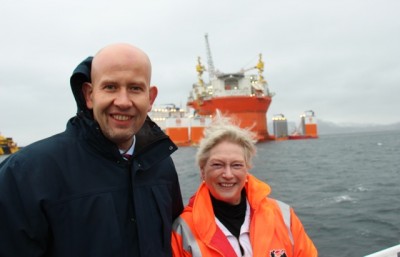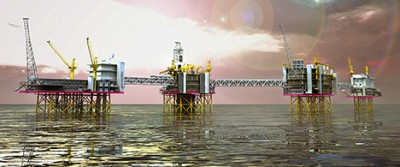Government claims that the huge new Johan Sverdrup oil field will create as many as 51,000 new jobs in Norway are now being drawn into doubt by the oil industry itself. Many of the jobs, they fear, may wind up overseas like Northern Norway’s troubled Goliat project did.

Oil & Energy Minister Tord Lien has earlier worried about the costs and delays encountered after major offshore construction projects destined for Norwegian oil fields were ordered from shipyards and factories abroad, for example in South Korea. The massive FPSO platform ordered in South Korea for the Goliat field off Northern Norway, for example, finally arrived in Hammerfest earlier this month, nearly two years delayed and 50 percent more expensive than originally projected.
Newspaper Dagens Næringsliv (DN) has reported that Lien is concerned about several other projects, including Statoil’s Aasta Hansteen, also at Hyundai in South Korea. DN reports that Statoil’s Gina Krog project and Total’s Martin Linge project are also behind schedule.

Lien has thus made a point of noting how Kværner of Norway is delivering the Edvard Grieg project on time and on budget to operating company Lundin Norge. He’s been encouraging operators on the Norwegian Continental Shelf to order new projects, for example those for the Johan Sverdrup field, at yards in Norway.
Development of the Sverdrup field has emerged as the new great hope for Norway’s oil industry, suddenly beleaguered since the price of oil plummeted last year. Norwegian firms Aibel and Aker have won major contracts tied to Sverdrup, but DN reported this week on concerns that much of the other work may be placed overseas.
That can mean that job creation won’t approach the 51,000 Lien has promised, at a time when oil jobs are being slashed industry-wide.
“The number reflects what was projected at the starting point, but with such hard negotiations as we see going on, I wonder whether (the jobs in Norway) will materialize,” Knut Sunde, director of the trade association Norsk Industri.
Lien, from the Progress Party, said the figure of 51,000 that’s been used stems from expectations over how contracts will be dealt out both nationally and internationally. “And we know that Norwegian suppliers are competitive,” Lien said.
Johan Sverdrup represents the largest oil field discovery in Norway since the 1980s and it lies just 140 kilometers southwest of Stavanger, in a mature area and waters that are relatively easier to work in than in the Arctic, where oil and gas exploration and extraction is risky, expensive and controversial. Sverdrup has had is share of conflict as well, but it’s valued at NOK 117 billion just in its its first development stage, and expected to keep life in Norway’s oil industry for years to come.
“Its development and operation will still lead to the creation of thousands of jobs and valuable contracts at a time when the industry really needs them,” Lien said.
newsinenglish.no/Nina Berglund

